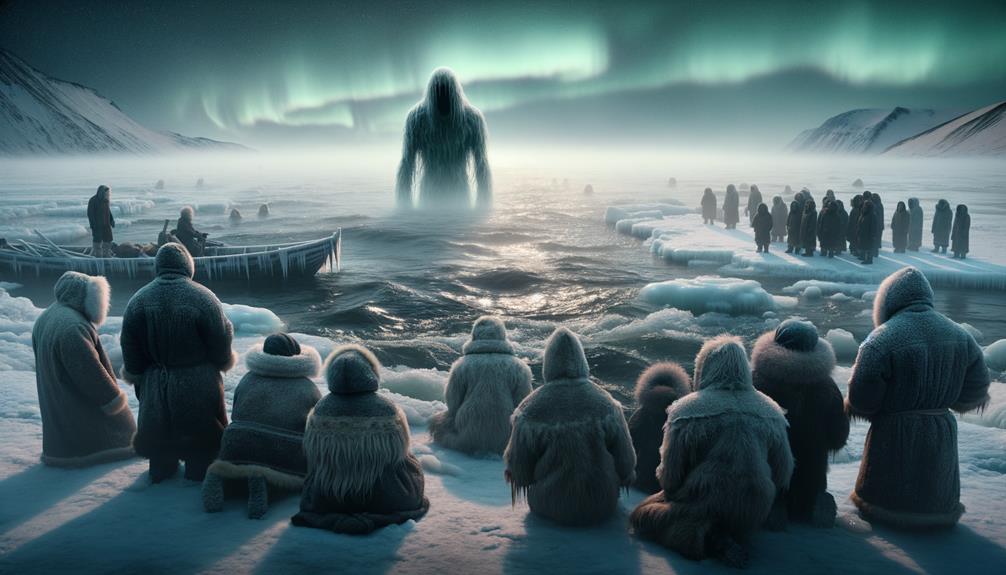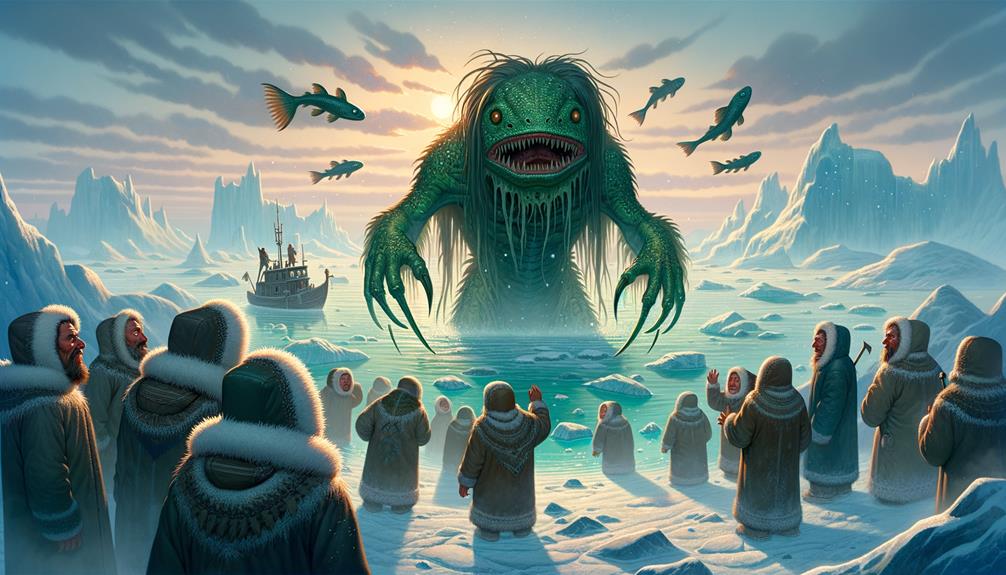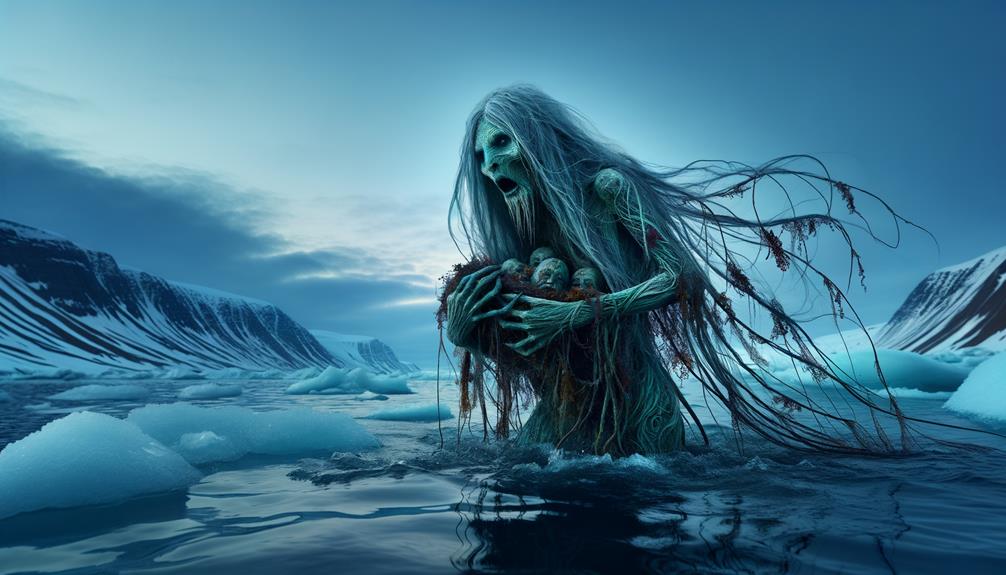Have you ever heard of the Qalupalik? It’s a fascinating creature from Inuit legends that dwells in the chilling depths of the Arctic seas. This mythical figure is often described as having a ghastly green hue, a mane of long hair, hands that resemble flippers, and terrifyingly long talons. Quite a sight to imagine, isn’t it?
The Qalupalik is known for her infamy of capturing naughty children who dare to get too close to the water’s edge. Sightings and tales of this sea spirit have been passed down through generations, making her a noteworthy character in Inuit folklore.
But there’s more to her story than just a spooky tale to scare children. The tale of the Qalupalik also serves as a cautionary lesson about the perils of the sea, while at the same time instilling a sense of respect for the mysteries that nature harbours. It’s a fascinating narrative, one that might hold deeper meanings about our own connection with the natural world.
So, why not delve into it a bit more? You never know what revelations about our relationship with nature you might unearth from this intriguing piece of Inuit lore.
Understanding the Qalupalik Legend
Let’s talk about the Qalupalik legend. There’s a figure in it that’s both mesmerizing and chilling at the same time. This water spirit, recognized by the Inuit as a snatcher of wayward children who venture too close to the sea, is quite the character. This sea-dwelling humanoid, with her uncanny charm and threatening aura, plays a big part in the stories of indigenous people, particularly those in the Inuit communities. The Qalupalik is more than just a creature of legend; it’s like a scary story told to keep kids in line.
In the colourful world of Inuit legends, the Qalupalik is known for a one-of-a-kind way of snatching children. She draws in kids with her humming, a sound that’s as fascinating as it is scary. Once they’re under her spell, the children are taken away, never to be seen again. There are stories that say the Qalupalik stays young by feeding off the youth of the children she abducts, which adds a rather grim layer to this already creepy tale.
To truly understand the Qalupalik legend, you need to see the two sides of its coin. On one hand, it’s an intriguing piece of cultural mythology. On the other, it’s a pretty effective way to keep society in check. While the story might give you the creeps, it sends a clear message about the importance of listening to your elders and being careful, especially when it comes to the treacherous sea in Inuit communities.
The Physical Description of Qalupalik

The Qalupalik, a legendary figure from Inuit folklore, is certainly a sight to behold. This sea spirit is imagined with skin that is a peculiar green, scaly or even slimy to the touch. Its hair is long, tangled, and dark, adding an element of mystery to its overall appearance. The Qalupalik’s semi-human, semi-aquatic form is further emphasized by the presence of fins that sprout from its head, back, and torso.
Here’s a quick rundown of the Qalupalik’s physical attributes:
| Characteristic | Description |
|---|---|
| Skin | Green, either scaly or slimy |
| *Hair* | Long, tangled, and dark |
| *Hands* | Webbed, with long, claw-like nails |
| *Aquatic Features* | Fins on its head, back, and torso |
These physical traits do more than just paint a picture of a formidable creature. They are integral to the Qalupalik’s role in the lore. For instance, it is thought that the creature’s long nails are used to snatch unsuspecting children who wander too close to the water’s edge. Thus, the physical description of the Qalupalik is key to understanding its role as a child-snatcher in Inuit folklore and its eerie existence as a sea spirit.
Sightings and Stories of Qalupalik

Although some may dismiss the Qalupalik as a simple story conjured by the Inuit community, there’s a significant number of sightings and bone-chilling tales that hint at the existence of this sea spirit in the frosty coastal areas of Canada and Alaska. The indigenous people’s folklore speaks of a spirit known as the Qalupalik, an aquatic being that resembles a human, with green skin, long hair, and razor-sharp nails. This creature is said to prey on children who stray too close to the dangerous Arctic waters.
The Inuit’s tales paint a horrifying picture of this spirit who is notorious for taking young victims into her amautik, which is a type of pouch. Depending on the narrative, some say she consumes these children, while others propose she nurtures them beneath the sea as if they were her own offspring. The eerie melody of the Qalupalik, offering hidden treasures, is a recurring theme in these stories.
These tales are more than just scary stories about a sea monster, they act as warning narratives, alerting children to the potential dangers of disobedience and venturing too close to the sea. As a result, the Qalupalik continues to be a striking figure in the tapestry of Inuit cultural mythology.
Qalupaliks Role in Inuit Culture

The Qalupalik is more than just a myth in the Inuit culture. It’s a story used to teach children about the risks of getting too close to the water. This tale is a crucial part of the indigenous people’s folklore, ingrained deeply in their daily lives, and serves as a lesson about respecting nature and the unknown.
The Qalupalik tale is a chilling story about kidnapping. The creature is known to take children who wander too close to the shoreline, symbolising the sea’s hidden dangers and unknowns. This narrative, shared over countless generations, is a stark wake-up call about the need for caution and respect towards nature.
The Qalupalik story still resonates today. Modern retellings in storytelling and art merge tradition with current themes, showing how this legend remains relevant. The Qalupalik, a creature from the ocean’s depths, is still a prominent figure in Inuit culture. The role of this mysterious sea spirit isn’t just to instill fear, but to convey a timeless message about our relationship with the natural world.
Comparing Qalupalik With Other Sea Spirits
Let’s have a chat about the Inuit’s Qalupalik and Japan’s Kappa, two sea spirits that have significant roles in their respective cultures. The Qalupalik, a creature known for kidnapping kids, is a rather chilling character in the tales told by the Arctic’s indigenous people. The sound of its spooky humming serves as a warning to children, teaching them to be wary of the sea’s mysterious elements.
On the other hand, the Kappa, native to Japan, has a lighter touch. It’s known for its mischievous behaviour, but it’s not always harmful. Interestingly, it’s often willing to ensure safety in exchange for cucumbers.
| Sea Spirit | Where it’s from | How it interacts with Humans |
|---|---|---|
| Qalupalik | Inuit | Grabs naughty children |
| Kappa | Japan | Plays tricks, trades safety for cucumbers |
In the stories about Kappa, you’ll hear about pranks and cucumber exchanges. In contrast, tales about Qalupalik serve as warnings, reminding us that the sea’s vitality can also pose a danger. What’s common in both is the message that nature deserves respect.
Artists like Joy Ang and Ningeokuluk Teevee create visual renditions that capture the eeriness of the Qalupalik. While these images can be quite scary, they also offer deeper insight into who this Arctic spirit is. It’s a testament to the richness of Inuit culture.
Frequently Asked Questions
What Is the Legend of Qalupalik?
Ever heard of the Qalupalik legend? It’s a truly hair-raising tale from the Inuit culture. The Qalupalik is believed to be a sea spirit that targets children who misbehave near the ocean. While some stories suggest she consumes these children, others believe she brings them up in an underwater world. It’s certainly a story that gives you the creeps.
What Is the Mythical Monster Called by the Inuit People?
Well, have you ever wondered about the mythical beings that our friends up North, the Inuit people, believe in? They have this fascinating creature known as the Qalupalik. This isn’t your typical fairy tale character though, it’s a sea spirit with a rather dark side. The Qalupalik has a reputation for snatching away children who don’t follow rules. It’s kind of like the Kappa from Japanese folklore, but with its own unique spin.
What Are the Mythical Creatures of the Inuit?
Inuit folklore is teeming with a rich variety of creatures, each with its own unique part to play in their tales. Some of these include the Ahkiyyini, Aningaat, Siqiniq, Qallupilluit, Saumen Kar, and Tizheruk. Some serve as warnings, cautioning about potential dangers, while others embody different elements of nature. This fascinating assortment of beings gives us a glimpse into the Inuit’s perception of the world around them.
What Are the Characteristics of the Qalupalik?
Check this out – the Qalupalik is a fascinating entity. Picture a being that looks somewhat human, but its skin is a unique shade of green. It has long hair, and its nails are longer than what we’d consider normal. Some say it’s got a creepy vibe about it. People have passed down stories that it snatches up kids who get too close to the ocean, perhaps using their vitality to keep itself young. Despite all these tales, the truth about its existence remains shrouded in mystery.


